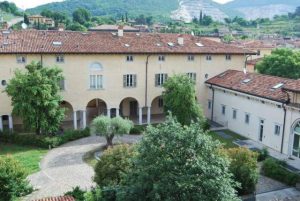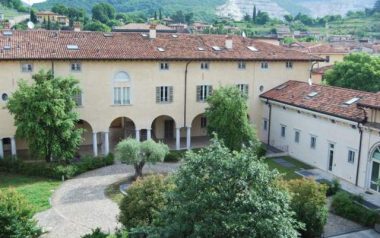Palace Chizzola Portesi
That noble sense of expansive, wide surfaces, with open and well-defined openings that has distinguished our entire architecture of the century. XVI, is clearly expressed in this beautiful house erected by the Chizzola.
Palace Chizzola Portesi (XVI century): On the outside, towards the mountain, the maximum simplicity in a volume, for the time of construction, quite remarkable: the only sign is the jambs of the well-marked stone windows. After the vaulted hall the portico conceived already with ample breadth as copiously will be seen in Brescia in the later decades. There are seven arches in the center which rest on matching Doric columns but far enough apart to carry a short, low lintel. Pleasant motif that will be repeated, with other proportions, in the palace Chizzola ai Cappuccini two centuries later. Few, as was said, and corresponding to the arches, the windows of the upper floor. Absent the cornice, the house definitely wants to be in the country. There is a hall instead, which extends towards noon, which has some sign of greater wealth with beautiful windows on the ground floor only, a sparse ledge cornice, and which ends with a short portico, surmounted by baltresca. On the ground floor there are some vaulted rooms that denote the ancient glory, but only one still preserves some paintings of the second half of the sixteenth century of a religious nature, an uncommon fact at that time when pagan histories were popular. It is located in the morning side. The pavilion vault is divided into many compartments: in the center the eternal Father among the blessing clouds and in two smaller squares at the ends overlook two angels with the making of this world (it is the eternal taste of the Brescian reality that is perpetuated); at the corners the four seasons and in the three central compartments three episodes of the Holy Scripture: Moses saved from the Nile, Joseph and the brothers, the burning bush. In a room connected with this environment a fresco of the century. XVII with the B.V. and S. Carlo Borromeo. The noble staircase is located near and parallel to the entrance hall. On the first floor in the evening there must have been the great hall, which is now all parted; towards the morning, on the other hand, four rooms still open, facing the street, very easily served, like the rooms in the evening, from a gallery above the portico, now all part of it too. The first two rooms have whitewashed walls, but we think they are as cool as the following two and perhaps a patient restoration could make the paintings live again. the third room has not only well preserved the high band, but also the beginning of the decoration of the walls with the heads of the caryatids, already repeated elsewhere, and part of the mirrors where perhaps are the paintings of the landscapes. The band, among the usual friezes, bears allegories of various kinds with illegible mottos, flanked by coats of arms of the Bresciane family, including those of the Bornati, Maggi, Avogadro, Avogadro del Giglio, the Fisogni with all the altered colors. The fourth and last room to the east has unfortunately the walls all whitewashed, but perhaps also frescoed, because even here runs a beautiful well decorated band. There are no coats of arms, but allegories and mottoes in quantity. We feel that the mania of symbolism and Hermeticism dear to the Academies begins. The allegories are framed in casrtigli digià barocchi. among the legible and less obscure ones there is, for example, a tower with the motto “SOL L’INDUSTRIA A NOI ALTARE”, then a portico with the inscription “CONCORDIAE AETERNAE”; in the east side a sphere e “I QUATTRO UNITI UNA SOL FORMA APPARE”, while on the opposite side there is a mountain with gushing water and the motto “SIMUL EADEM” and next to it “OGNI SUO EFFETTO IN NOI NATURA SCOPRE”. All together a nice mess.
Qui i Chizzola radunavano gHere the Chizzolas gathered the intellectual friends of the time. There is news of this in a letter by Messer Aleni addressed to Nicolò Tartaglia in Venice on 20 January 1548 (published by Orioli). Aleni invites the scientist to intervene in the academies that were held in Rezzato in the name of the “magnificent and excellente M. Jacopo Chizzola and M. Theseo Lana”. It seems that the Tartaglia intervened from March to October 1549.li amici intellettuali del tempo. Vi è notizia di questo in una lettera di Messer Aleni indirizzata a Nicolò Tartaglia a venezia il 20 gennaio 1548 (pubblicata da Orioli). Aleni invita lo scienziato a intervenire nelle accademie che si tenevano a Rezzato in nome del “magnifico et excellente M. Jacopo Chizzola et M. Theseo Lana”. Sembra che il Tartaglia vi sia intervenuto dal marzo all’ottobre del 1549.
 Palace Chizzola Portesi
Palace Chizzola Portesi
Palace Chizzola Portesi – Fonti Fausto Lechi, “Dimore Bresciane, in cinque secoli di storia”

